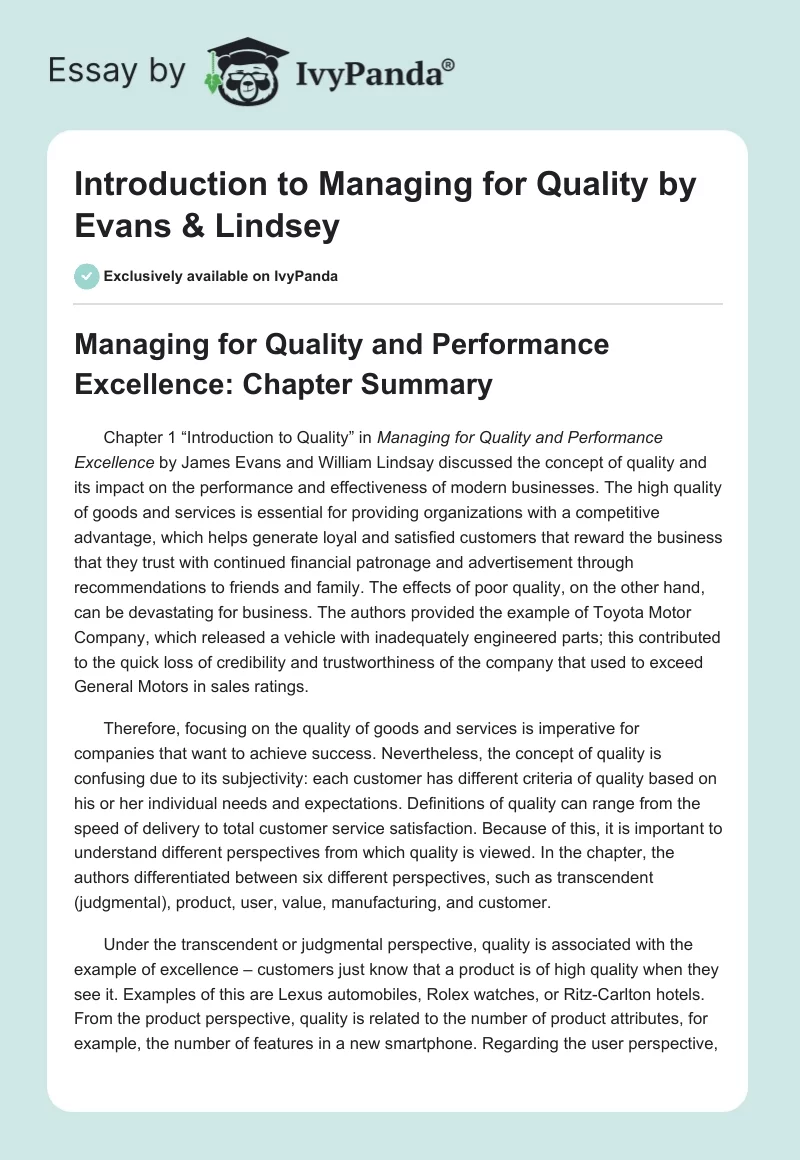Managing for Quality and Performance Excellence: Chapter Summary
Chapter 1 “Introduction to Quality” in Managing for Quality and Performance Excellence by James Evans and William Lindsay discussed the concept of quality and its impact on the performance and effectiveness of modern businesses. The high quality of goods and services is essential for providing organizations with a competitive advantage, which helps generate loyal and satisfied customers that reward the business that they trust with continued financial patronage and advertisement through recommendations to friends and family. The effects of poor quality, on the other hand, can be devastating for business. The authors provided the example of Toyota Motor Company, which released a vehicle with inadequately engineered parts; this contributed to the quick loss of credibility and trustworthiness of the company that used to exceed General Motors in sales ratings.
Therefore, focusing on the quality of goods and services is imperative for companies that want to achieve success. Nevertheless, the concept of quality is confusing due to its subjectivity: each customer has different criteria of quality based on his or her individual needs and expectations. Definitions of quality can range from the speed of delivery to total customer service satisfaction. Because of this, it is important to understand different perspectives from which quality is viewed. In the chapter, the authors differentiated between six different perspectives, such as transcendent (judgmental), product, user, value, manufacturing, and customer.
Under the transcendent or judgmental perspective, quality is associated with the example of excellence – customers just know that a product is of high quality when they see it. Examples of this are Lexus automobiles, Rolex watches, or Ritz-Carlton hotels. From the product perspective, quality is related to the number of product attributes, for example, the number of features in a new smartphone. Regarding the user perspective, quality refers to the extent to which the expectations of different customers are met (fitness for intended use).
For example, both Honda Civic and Cadillac Escalade are fit for use; however, they serve the needs of two completely different audiences. Under the value perspective, quality is defined as the relationship between the benefits of products and their price. The manufacturing perspective, on the other hand, explains quality as the conformance to specifications. For example, companies that conform to the same standards of production and delivery usually show higher quality indicators. Lastly, the customer perspective defines quality as the combination of product or service characteristics that allow companies to satisfy the specific needs of their clients (both internal and external). An example of this is Hilton Hotels Corp., which trains employees to anticipate the different needs of their guests, personalize their services, and deal with complaints.
Since quality has been shown to be an essential component of customer satisfaction and competitive advantage for companies, the practice of total quality management (TQM) appeared in organizations to maintain their reputation. Currently, managers understand that they must listen to customers’ needs, establish trusting relationships with them, develop innovative strategies, deliver high-quality products, and reward their employees in order to truly align with the characteristics of quality. Total quality management systems are people-focused; they aim at a continual increase in customer satisfaction through changes in systems, methods, and tools. TQM also contributes to the development of performance excellence, which is an integrated approach for:
- Delivering ever-improving value to customers;
- Increasing overall organizational effectiveness and sustainability;
- Enhancing organizational and personal learning.


